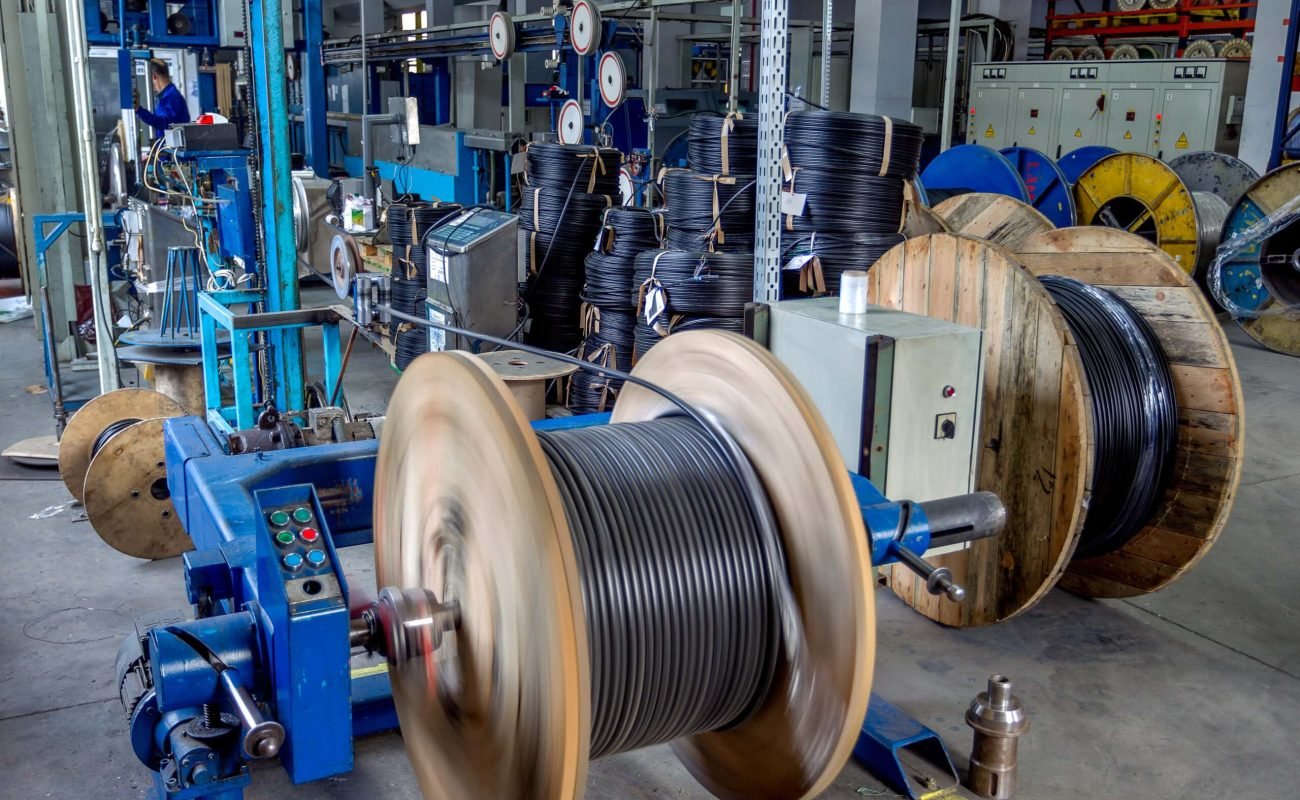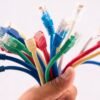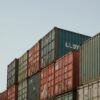Selecting an optimal optic cable production line is achievable through a practical, detail-oriented approach tailored to various optic cable types.
Navigating the optic cable production industry can be challenging for newcomers or those who haven’t made purchases in some time. However, finding a production line to meet your needs for years to come simply requires thorough research and expert consultation.
To choose the appropriate production line, consider the two primary optic cable types: indoor و outdoor.
Grasping the distinctions between these cables is crucial for identifying the most suitable production line.
In this guide, we offer an overview of the selection process, delving into the specifics of each cable type to inform your decision-making.
The Indoor Optic Cable
Indoor optical cables are designed for wiring applications within buildings, providing a secure enclosure for wiring, particularly between walls. Their use extends to plenum air handling ducts, barriers, and interfloor spaces. Constructors also employ them in data center flooring installations.
These cables are built to endure tensile stress due to their exceptional flexibility. Although they possess a unique aesthetic, their primary focus is on long-term durability.
In this guide, we will explore four types of indoor optical cables, ensuring the original meaning is preserved:
- Simplex/Duplex soft cable
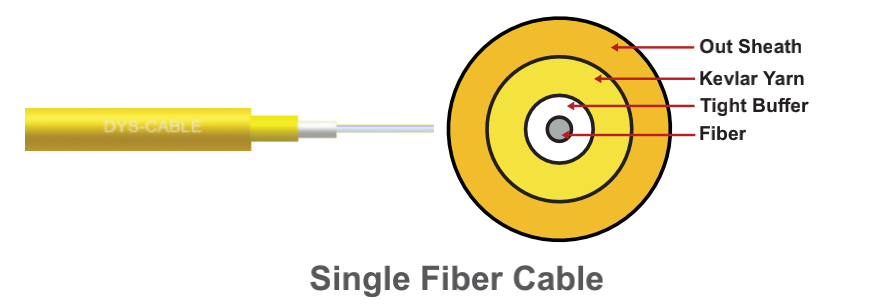

Simplex و duplex soft cables are two types of fiber optic cables.
A simplex cable is a single fiber optic cable that allows data to flow in one direction only. It is commonly used for applications that require a one-way data transfer, such as cable TV systems.
A duplex cable, on the other hand, contains two fibers, allowing data to flow in both directions simultaneously. It is commonly used in applications that require two-way communication, such as computer networks and telecommunication systems.
Soft cable refers to the cable’s flexibility, making it easy to bend and route around corners or obstacles. Soft cables are ideal for indoor installations, as they are often more manageable and less rigid than outdoor cables.
- Simple/Duplex Armoured cable


Simplex/Duplex Armoured cable is a type of fiber optic cable that is designed to provide extra protection against damage and breakage. It consists of one or two optical fibers enclosed in a metal or plastic tube, which is then covered with a layer of steel or aluminum armor. The armor provides additional strength and durability to the cable, making it more resistant to environmental hazards like moisture, dust, and impact.
The difference between Simplex and Duplex Armoured cable is the number of fibers they contain. Simplex Armoured cable has a single fiber, while Duplex Armoured cable has two fibers. Both types are commonly used in outdoor and industrial applications where the cable may be exposed to harsh conditions, such as underground or overhead installations, and where high reliability and security are required.
- FTTH cable

The FTTH cable is the life of present-day connectivity. It means “fiber to the home”. With FTTH cable, the home is usually the end-user. There is the FTTH flat drop cable and the self-support FTTH flat drop cable.
The Internet speed we enjoy today is a result of the high data transmission of the FTTH cable.
- Mini/Micro cable
Mini/Micro cable is a type of fiber optic cable that is smaller in diameter and lighter in weight than standard cables.
The compact design of the cable makes it easier to install in tight spaces or in areas with limited room for cable routing.
Mini/Micro cables are often used in applications such as fiber to the home (FTTH) and in-building installations.
They typically consist of a single fiber or a small number of fibers and are available in various configurations, including colored fibers and Yarns. Due to their smaller size, Mini/Micro cables have lower cable capacity and may be more susceptible to damage from bending or crushing, but they can offer advantages in terms of flexibility and ease of installation.
- Distribution cable
Distribution cable is a type of fiber optic cable used in telecommunication networks.
It is designed to connect distribution points, such as poles or buildings, to customer premises equipment (CPE).
The cable typically contains several tight-buffered fibers, which are surrounded by strength members and a protective outer jacket. The fibers are typically color-coded for easy identification, and the cable can be designed to be either indoor or outdoor-rated.
Distribution cables can be used in a variety of applications, including fiber-to-the-home (FTTH), fiber-to-the-building (FTTB), and fiber-to-the-curb (FTTC). They are typically smaller and more flexible than backbone cables, making them easier to install and handle.
Main Components of an Indoor Optic Cable
The main components of an indoor optic cable are as follows:
- Fiber core
The fiber core is the part that transmits light in the optic fiber cable. The fiber core guides the light as the cylinder of glass runs through its length. Some are made of plastic though.
It has a medium enclosure that features a lower index of refraction.
- Tight buffer/TB
A tight buffer as a component of an indoor optic cable has a thick coating. You’ll find it in most intra-building construction, plenum applications, and risers.
The coatings are of plastic materials. They are applied to the surface of every single fiber.
- Aramid
Aramid is a fiber-like material that provides tensile strength in the cable. It is strong and helps to bundle loose tubes during and after installation.
If a contractor or technician pulls a cable into a duct, the aramid protects the fiber. This stops the fiber from feeling the tension as it goes to the aramid yarn.
- Steel Wire
In fiber optics, central strengthening is the work of a steel wire. Most steel wires consist of non-alloy carbon steel. They are of high strength too and help to support tension forces.
- Jacket(LSZH/PVC)
Some indoor optic cable comprises a jacket material that is LSZH. Which means Low Smoke Zero Halogen. While some are of PVC, which mostly comprises polyvinyl chloride.
The PVC is soft but emits toxic gases like hydrochloric acid when it burns. The PVC is flexible too. While the LSZH jacket is flame resistant. Even though it’s more expensive, it does not emit toxic fumes when it burns. As it is free from halogenic materials.
- Steel Armored Cable
The main electricity supply is where the steel armored cable is put into use. It is an auxiliary and power control steel used mostly for cable networks. It is an indoor fiber component for cable ducting.
The Outdoor Optic Cable
As the name suggests, outdoor optic cables are specifically designed for exterior use. Sporting a robust structure, they can endure severe weather conditions and resist wear and tear from various environmental factors and mechanical forces.
These cables possess greater strength than their indoor counterparts, allowing them to handle temperature fluctuations and resist UV degradation.
Though outdoor conditions may pose challenges, outdoor optic cables must meet specific criteria for safe and effective operation.
Adequate protection is essential for optical fibers to function optimally in any environment, and the components of outdoor cables must reinforce their durability and resilience.
Types of Outdoor fiber Optic cables are:
- GYXY cable
GYXY cable is a type of fiber optic cable that is commonly used in indoor and outdoor applications. It consists of one or more optical fibers, which are protected by a layer of aramid yarn or glass yarn, and a PVC or LSZH outer jacket.
The cable is designed for use in direct burial, aerial, and duct applications, and can be used for both short and long distance communications. It is typically used in local area networks (LANs), wide area networks (WANs), and other telecommunications applications where high-speed data transmission is required.
The GYXY cable is known for its high strength, durability, and resistance to environmental factors such as temperature, moisture, and UV radiation. It is widely used in telecommunications, broadcasting, and other related industries.
- GYXTW Cable
GYXTW cable is a type of outdoor fiber optic cable widely used for telecommunication networks.
The cable is designed with a central strength member, surrounded by single or multiple layers of the loose tube containing optical fibers, and protected by a corrugated steel tape armor and an outer polyethylene (PE) sheath.
The GYXTW cable is suitable for direct burial installation, and it can withstand harsh environments such as high temperature, moisture, and mechanical stress.
The cable is also available in different fiber counts to meet various communication needs. It is commonly used for long-distance and metropolitan area networks, as well as for CATV and other communication applications.
- GYXTC8S
GYXTC8S is a type of fiber optic cable that stands for “Gel-Filled, Central Tube, Corrugated Steel Tape, Eight Figure-8-Shaped Self-Supporting Cable”. It is designed for outdoor aerial installation and can support long spans without the need for additional support structures
The central tube is filled with a water-blocking gel to prevent water penetration. The cable is wrapped in corrugated steel tape to protect against environmental factors like temperature changes and rodents.
The eight figure-8-shaped self-supporting design means that the cable can be easily installed and supported by a messenger wire, making it a popular choice for telecom companies looking to provide high-speed internet and other communication services in rural areas.
- ADSS Cable:

كابل إي دي إس إس stands for “All-Dielectric Self-Supporting” cable. It is a type of fiber optic cable designed to be installed in aerial environments without the need for a supporting messenger wire. The cable is made with a central strength member surrounded by layers of aramid yarns and a UV-resistant jacket.
ADSS cables can span long distances between utility poles and are often used by power utilities to carry high-speed data and video signals. Due to their all-dielectric construction, they are immune to electrical interference and lightning strikes, making them a reliable choice for outdoor installations.
Main Components of an Outdoor Optic Cable
- الألياف الأساسية
The fiber core in an outdoor optic cable also aids speedy light transmission. It has a more robust jacket structure for environmental protection. The properties are anti-UV and crush resistance.
Even though it’s stronger than the indoor optic cable. The weight is of average standard. Making it easy for technicians to handle.
- Jelly
The prevention of water ingress is very important for outdoor cable installation. It is the main reason why most outdoor optic cables have icky-pick gel.
The jelly is usually non-hygroscopic. It is inside the jacket of the cable. The types used during telecommunication installation. They make cables durable, and excellent for hard-wearing purposes.
- PBT
It is also a coating material used for loose tubes. While the primary coating in the optical fiber is strong enough. The PBT is the extrusion material for the final coating.
PBT is the short form for Polybutylene terephthalate. It is used for auxiliary coating in outdoor fiber optic cables.
- Central Strength Member
Outdoor data cables comprise central strength members. It’s high ratio of strength/weight makes the cable suitable for frequent rain areas.
It is an additional component to an already coated cable. It helps to curb detachment in the paired ferrules.
Normally, we can choose FRP or steel wire as it is.
- Water Blocking Tape
This tape helps to shield fiber optic cables from the corrosive impacts of water. Most outdoor optic cables are for longitudinal use. And, water can penetrate from anywhere under the ground.
A water-blocking tape has semi-conductive properties to prevent longitudinal liquid penetration. Its composition is mainly polyester non-woven fabric.
- Aramid Yarn
Aramid yarn is an important determinant of a fiber optic cable’s strength. Even though the central strength member helps its power. The aramid yarn helps to fulfill the tensile force requirements.
It also adds peripheral strength to the fiber. This is needed to meet the yanking force during installation.
- Stranded Steel Wire
The spinning of individual steel wires to close over a central core is what makes up the stranded steel wire.
It provides resistance to abrasion, due to the large conductor the spun wire forms. Stranded steel wire is formed to provide high resistance to metal exhaustion.
- Steel Wire Armored
Just as it’s useful for indoor optic cables, it is useful in outdoor cables too. The steel wire armor serves the same purpose of protection.
It has a hard-wearing design to aid durability. It works well for industrial plants. Especially those that are not subject to mechanical damage.
- Jacket(HDPE/PVC)
HDPE is short for high-density polyethylene. It is also a thick coating system. The HDPE is formulated for outdoor cable installation. It is a combination of polyurethane foam insulation and a watertight coating.
PVC coatings are durable and cost-efficient for outdoor fiber optic cable installation. They are used in a wide variety of telecommunication wiring.
How to Choose the Right Production Line
We’ve covered various production line types, and now it’s time for the main guide on selecting the right production line.
Note: Thoroughly evaluate an optic cable production line manufacturer; choose those with proven experience. At Hongkai, we’ve been delivering exceptional services since 2005, possessing expertise in fiber optic cable production.
In this section, we’ll discuss diverse production lines, particularly those utilized in manufacturing distinct fiber optic cables.
We’ll start with a simple, comprehensive production line and progress to more intricate ones for in-depth guidance.

The Tight Buffered Production Line:
We have a video on the tight-buffered production line هنا. Feel free to go through it.
The tight-buffered production line is an important process of indoor cable production. The right one features easy stripping and increases high productivity.
The following parts make up the tight-buffered production line:
1. pay off: It helps to increase cable quality during fiber attenuation.
2. Extruder: To get your desired shape, an extruder helps to complete the plastic extrusion process.
3. Electric cabinet: It is an electrical enclosure part of the production line. The electrical cabinet helps to provide protection. And, aids the easy operation of the production line.
4. Water trough and tank: After extrusion, the water trough and tank help to cool the jackets.
5. OG gauge: This is the outside diameter gauge that measures the cross-sectional area.
6. Capstan: To stabilize the speed of your production line, the capstan is needed. It works with caterpillars.
7. Dancer of take-up: These are for cable speed control during production.
8. Take-up: It offers reel ranges to increase consistent production.
Tight buffering is commonly found in most short-distance indoor wiring. It involves using adequate plastic covers, tightly packed around the optical fiber’s jacket surface, to protect the cable from external factors.
The tight-buffered production line utilizes an extruder for fiber coating. The creation of bulges in PVC, LSZH, and other similar nylon components is achieved through the tight buffer fiber extruding line. This production line offers a rapid manufacturing speed and can produce single-core, tightly-encased optical fibers.
Control technology plays a crucial role in the operation of this production line, as it merges a Programmable Logic Controller (PLC) with an Industrial Computer (IPC). The IPC + PLC mode allows for asynchronous functioning of the entire production line as well as independent operation of individual machines. Moreover, it includes parameter display and other customizable settings.
ال Outdoor Optic Cable Sheathing Production Line
The outdoor optical cable sheathing production line specializes in manufacturing large-scale external cables.
It is designed for creating massive underground cables, including submarines, OSP induction, and other associated installations.
This production line focuses on constructing cables that safeguard the fibers from non-conductive environments encountered during installation.
High-quality cables that resist such harsh conditions are produced utilizing an outdoor cable machine.
You can watch a video that covers the outdoor production line here.

This production line consists of the following parts:
1. Payoff: It helps to integrate wire. And does the stranding, bunching, and spooling during production.
2. Dancer of pay off: The flexible part that helps maintain regular cable tension.
3. Aramid yarn device: The aramid yarn device is used during fiber coating for protection.
4. Jelly machine: It is used during underground cable production. It fills jelly in the inter-spaces between the conductors.
5. Armored equipment: To produce a flexible conduit, you need this part of the line. It adds high tensile strength to cables.
6. Extruder: To create a consistent cross-section during production, an extruder does this at a high speed.
7. Electric cabinet: It helps to control and access the production line. Asides from the safety it provides, the visuals it provides are helpful. It makes the complex production line, each to operate.
8. OD gauge: The outside diameter gauge helps to determine electric ampacity. This curbs the risk of cable damage.
9. Capstan: For the outdoor cable line, the capstan does the enormous pulling. The large-diameter wires need a slow production speed. That is what the caterpillar capstan is meant for.
10. Spark machine: This helps in data processing. And, it detects defective wires.
11. Printer machine: It integrates into the production line for cable extrusions.
12. Dancer of take-up: used for unwinding applications. The outdoor production type features maximum rigidity. Which is reliable for large reels.
13. Take-up: The outdoor production line take-up differs from pay-offs. Especially how it guides the cycle speed of spools.
Things to Consider Before Choosing an Optic Cable Production Line
The fiber optic cable industry relies on a multitude of components, regardless of the cable type being produced. These components include spark machines, pay-offs, and various materials such as aluminum, plastic, steel, and glass.
The production line utilizes these parts to construct cables, incorporating small elements like yarns and wires, as well as larger components such as extruders and electrical cabinets.
Over time, these components have significantly evolved, offering increased safety, visual appeal, sophistication, and overall quality. They have adapted to new optic cable production lines and are employed in more inventive ways.
The fundamental configuration of any production line is composed of the following elements:
1. Pay off:
2. الطارد
3. Electric cabinet
4. Water trough and tank
5. OD gauge
6. Dancer of taking up
7. Take-up
Many components serve the same purpose across various production lines, with the primary distinction being the extruder level added, based on the desired cable size. Indoor fiber optic cables consist of several parts, including the core, tight buffer, and aramid. These components combine to form high-quality optic cables, like those used in the telecommunications industry.
Although the terminology may seem intricate, it’s crucial to understand how the fiber core and aramid relate to the other elements of an indoor optic cable structure. This knowledge will enable you to visualize and grasp the functioning of indoor fiber optic cables.
In the following section, you will explore the structure of an indoor fiber optic cable in depth.
Keep reading.
As discussed earlier, the indoor fiber optic cable is made up of the following components:
1. Fiber core
2. Tight buffer/TB
3. Aramid
4. Steel wire
5. تغليف
6. Steel Armoured
1.FIber core:
As we discussed earlier, the fiber core is the part that guides the light. In a fiber optic cable, it is a very vital component. Most fiber optic cable manufacturers buy fiber cores differently. The popular companies that sell them are:
2. Tight buffer
The tight package is the most central part of making indoor fiber optic cable besides FTTH.
It consists of thick jackets that are suitable for general intra-building. The tight buffer structure consists of two parts:

- Fiber core
- Jacket/sheathing
To manufacture this product, you will need a complete production line.

HK-30 IPC+PLC Control Tight Buffer Production Line
3. Aramid Yarn
It is important to note that the reinforcement is to achieve a purpose, to help protect fragile fiber, such as aramid; its role is to make the tensile strength of the fiber optic cable, and in the indoor fiber optic cable only needs to add aramid discharge frame can meet the aramid filing requirements;
The common indoor fiber optic cable with aramid to increase the tensile properties of the product have the following in common.
- Tight buffer/TB
- Yarn
- Jacket/Sheathing
It is processed for the second time after the tight pack is made, so they have some differences in the production line:
The production line structure changes to:
- Fiber cores’ pay off (1-12 heads)
- Yarn’s pay off device
- The model of the extruder increased to HK-50
- An accumulator is added. This is to eliminate the need of stopping the complete production line. Especially when bobbin change is required.

HK-50 IPC+PLC Control Simplex/Duplex Soft Cable Production Line
4. Steel wire:
Steel wire has stronger bending resistance and tensile strength, generally has applications to outdoor/aerial operations are used to strengthen the steel wire as a member
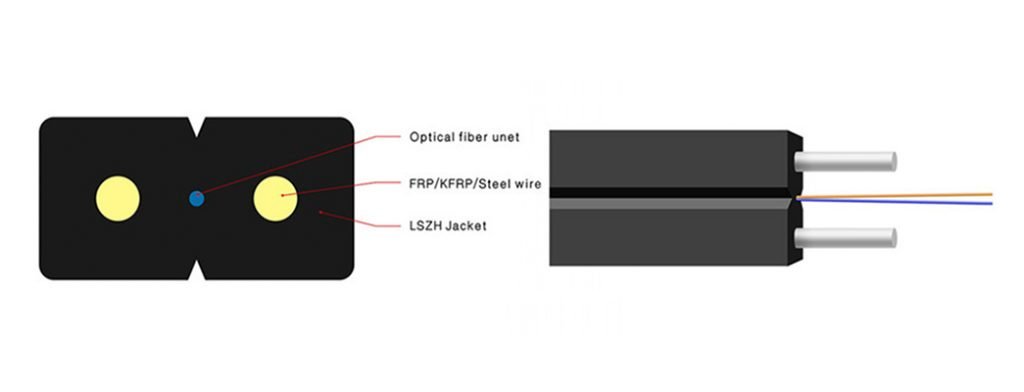
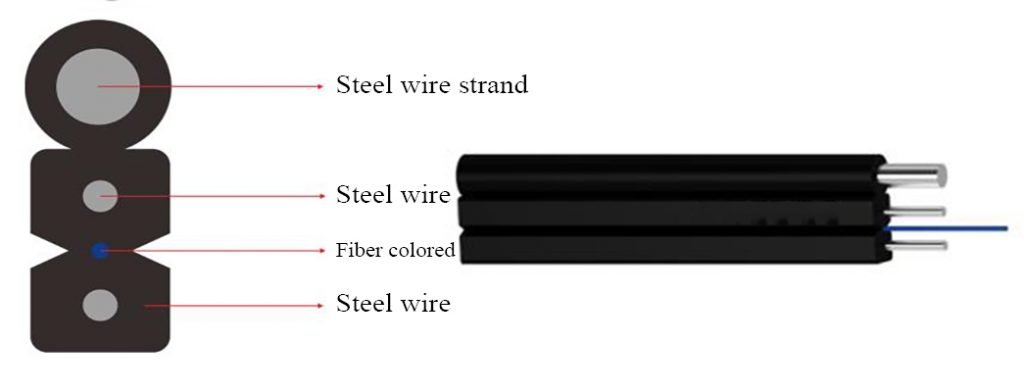
In indoor fiber optic cable, steel wire is only used in FTTH fiber optic cable. These products have the following structure:
- Fiber core
- Steel wire
- Jacket/sheathing
In the case of the same extruder as the flexible fiber optic cable line.
The production line structure here changes to:
- fiber cores’ pay off (1-6 heads)
- The addition of the steel wire pay off device
- The addition of the steel wire strand pay off the device
(ps: because of the non-conductivity/longer life/corrosion resistance of FRP, here sometimes FRP will replace steel wire as a reinforcement)

HK-50 IPC+PLC CONTROL FTTH DROP CABLE PRODUCTION LINE
5. Jacket/Sheathing
This is the final step in fiber optic cable production. However, a point to consider here is the selection of an appropriate extruder model. Here is a list of common model choices:
If you have the same product but different speed requirements, feel free to contact HongKai to communicate your requirements.
| Model | HK-30 Extruder | HK-50 Extruder | HK-70 Extruder |
| OD | 0.5-2.0mm | 0.6-4.0mm | 1.5-12mm |
| Production Speed | 350m/min(TB) | 120m/min (FTTH) | 75m/min(8.0mm) |
6. Steel Armoured
Generally speaking, Spiral Kai is only used for indoor or outdoor soft cable, and that’s it, and the equipment used to manufacture it is quite special
First, it is necessary to first flatten the wire and then wrap it around the outside of the soft cable in a spiral-like manner.
The Main Structure of an Outdoor Fiber Optic Cable
The components below form an outdoor optic cable:
- Fiber core
- Jelly
- PBT
- Aramid Yarn
- Water blocking tape
- Stranded steel wire
- تغليف
1. Fiber core
The outdoor cable has multiple cores. The cores need to be covered with different colors. The colors help to differentiate them. The coloring machine is used to achieve this.
HK-235 Fiber Coloring And Rewinding Machine
2. Jelly/PBT
In multiple cores of fiber, the jelly helps to prevent them from rubbing against each other.
It also protects them with PBT as the outer sheath. All these operations need to be done with a single line The finished product is called the loose tube.
Here’s the production process for these multiple cores:
| Fiber cores | ≦144 | ≧144 |
| Fiber pay offset | 12 | 24 |
| Finish OD | 1.8-2.0mm | 2.2-2.5mm |
| Loose tube lines produce speed | 350m/min | 250m/min |

HK-50 IPC+PLC CONTROL LOOSE TUBE PRODUCTION LINE
3.Central Strength Member/water blocking tape
In the case of multiple cores, reinforcement is added. Including the same outer diameter as the tube in the middle. It helps to prevent the loose tube from being crushed. Or, further extended into deformation after sheathing due to rubber shrinkage.
During the production process, here’s what’s done:
- We combine the multi-core tubes
- Tie the yarn
- Add water blocking tape
Which is the most important step in the cable production process. This combination helps the cable core to remain loose.
All in all, the strength of a good equipment supplier is reflected in the equipment they provide.

HK-SZ LOOSE TUBE BUNCHED PRODUCTION LINE
4. Stranded steel wire/Armour/Aramid Yarn/Sheathing
We add all the reinforcement parts for fiber production. The stranded steel wire increases the cable’s compressive properties. While aramid yarn strengthens the tensile properties at high altitudes.
A high hardness sheath material, such as the highest strength large HDPE is generally used here.
A few points to note:
- In terms of the Stranded steel wire, we can all use the same FTTH line.
- Unlike indoor fiber optic cables, the aramour process requires two stranded steel wires to be stranded at the same time in order to ensure the overall compactness.
- Here Armour is different from steel armoured, it is not only used with outdoor fiber optic cable, the manufacturing equipment is also completely different, the material used can be generally steel/aluminum tape

HK-90 OPTICAL CABLE SHEATHING PRODUCTION LINE
For example
We have examined and delineated the structure of each cable and the required equipment for production, providing an overview of various cable production processes. Join us as we address the following questions, serving as a summary of the topic.
1. How to produce the duplex soft cable?
First, let’s analyze how the cable is structured:
According to the product diagram, it is not difficult to analyze that it is composed of these parts:
- Fiber
- Tight buffer
- Kevlar Yarn
- تغليف
Next, we configure the devices one by one for each structure:
1.Fiber
Get the original fiber core from these companies:
2.Tight buffer

HK-30 IPC+PLC control tight buffer production line
3.Kevlar yarn/sheathing
HK-50 IPC+PLC CONTROL SIMPLEX/DUPLEX SOFT CABLE PRODUCTION LINE
2. How to produce the ADSS cable?
In the same way, we first analyze the cable:

- Fiber(Multicolor)
- أنبوب فضفاض
- Tube*6 cores with 1 Central Strength Member
- Water blocking tape/ Ripcords/ Aramid Yarn/ Sheathing
Next, we configure the devices one by one for each structure:
1.Fiber(Multicolor)
HK-235 Fiber Coloring And Rewinding Machine
2.Loose tube

HK-50 IPC+PLC CONTROL LOOSE TUBE PRODUCTION LINE
3.Tube*6 cores with 1 Central Strength Member

HK-SZ LOOSE TUBE BUNCHED PRODUCTION LINE
4.Water blocking tape/ Ripcords/ Aramid Yarn/ Sheathing

HK-90 OPTICAL CABLE SHEATHING PRODUCTION LINE
We can also match the specific configuration of the production line according to the actual specifications of the cable. If there are special requirements, we can provide our customers with free and best-quality solutions.
Final Words
When a choice feels off about your purchase, seek professional service. Our expert team at Hongkai is here to help you. We can provide the perfect production line to meet your optic cable production needs.
Feel free to call for a free consultation. And ask our professional technicians any question concerning a production line. It will help inform your choices and help you make better decisions.
Guangdong Hongkai Optical Cable Equipment Technology Co.,Ltd
Discover how our company revolutionizes communication, making it a must-click experience!






